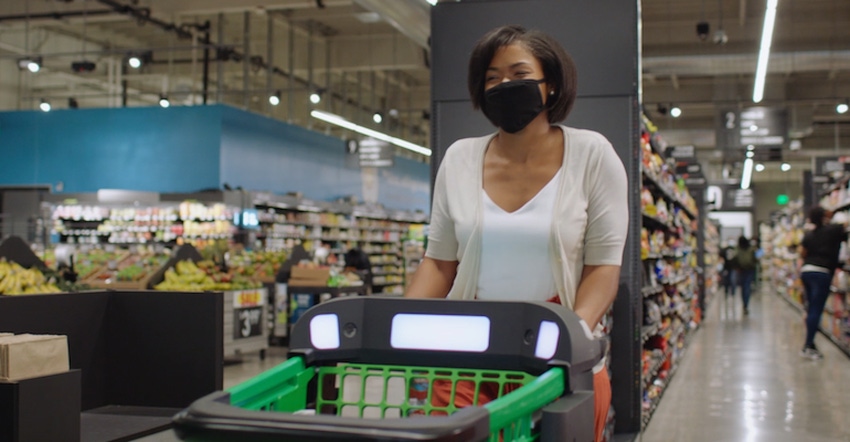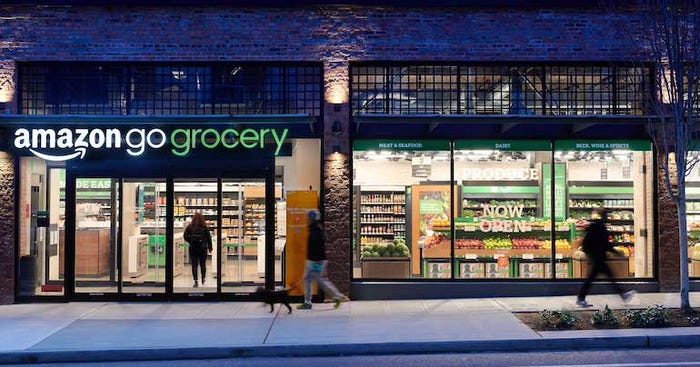Robust fiscal-year performance comes as founder Jeff Bezos shifts role.
February 3, 2021

Amazon vaulted over the $100 billion mark in sales with 44% growth and nearly doubled Wall Street’s earnings-per-share forecast for its fiscal 2020 fourth quarter.
The strong fiscal year finish came as Amazon prepares for a changing of the guard. In its fourth-quarter conference call with analysts late Tuesday, the e-tail giant announced that founder Jeff Bezos is stepping down as CEO will transition to the role of executive chairman.
For the quarter ended Dec. 31, Amazon tallied net sales of $125.56 billion, compared with $87.44 billion a year earlier. Excluding the impact of changes in foreign exchange rates, sales climbed 42%. Online sales came in at $66.45 billion, up 46% (43% excluding foreign exchange) from $45.66 billion in the prior-year period.
Amazon’s physical store sales, which include Whole Foods Market, declined 8% (7% excluding foreign exchange) to $4.02 billion from $4.36 billion in the 2019 quarter. That followed a 10% year-over-year decline in the third quarter, though sequentially physical store sales rose 6.2% from the third to fourth quarters. During fiscal 2020, the company saw physical store sales decreases in three out of four quarters, with an 8% gain in the first quarter followed by a 13% drop in the second quarter.
For the full 2020 fiscal year, Seattle-based Amazon totaled net sales of $386.06 billion, up 38% from $280.52 billion in 2019. Excluding the effect of foreign exchange, net sales grew 37% year over year. Online sales surged 39.7% to $197.35 billion from $141.25 billion a year ago.
Fiscal 2020 physical store sales were $16.22 billion, down 5.6% from $17.19 billion in 2019.

Amazon’s physical-store sales come mainly from its Whole Foods Market unit and exclude online orders made via its brick-and-mortar brands, such as Prime Now delivery and pickup through Whole Foods stores.
Currently, Amazon’s U.S. physical stores include 502 Whole Foods Markets, eight Amazon Fresh grocery stores, two Amazon Go Grocery stores, 26 Amazon Go convenience stores, 24 Amazon Books stores, 29 Amazon 4-Star outlets and seven Presented by Amazon pop-up locations.
For the fourth quarter and full year, Amazon topped the high end of its own sales estimates as well as those of industry analysts. On average, analysts projected quarterly sales of $119.7 billion (in a range of $113.73 billion to $123.18 billion) and year-end sales of $379.97 billion (in a range of $371.65 billion to $383.69 billion), according to Refinitiv.
“Revenue for the quarter was $125.6 billion versus our guidance range of $112 billion to $121 billion,” Amazon Chief Financial Officer Brian Olsavsky said in the conference call yesterday. “We kicked off the holiday season early for customers with Prime Day in October versus its usual timing in Q3. We then saw strong seasonal holiday demand through Q4. Our Q4 results also largely reflect the continuation of demand trends we have seen since the early months of the pandemic, particularly as people are staying at home, including for household staples and other home products.”
Amazon’s Prime customer benefits program, now with an estimated 140 million-plus U.S. members, remained a big sales generator.
“We saw sales growth across our major product categories, led by strong Prime member engagement,” Olsavsky said. “Prime members continued to shop with greater frequency and across more categories than before the pandemic began.”
Grocery sales also were robust for Amazon in the quarter, according to Olsavsky.
“We’re reaching more customers with our grocery offerings. In Q4, we had another strong quarter that largely reflects the continuation of demand trends from Q3.”
David Fildes, director of investor relations at Amazon, outlined the company’s brick-and-mortar food and grocery retail strategy with its Amazon Go, Amazon Go Grocery and Amazon Fresh banners.
“On the grocery point, we’ve got a couple different formats. The Go Grocery has a couple of locations open and off to a good start. A lot of interest in those and the technology that those offer, as well as the Amazon Fresh locations. So we’re at about eight [Fresh] locations open and I think in the neighborhood of about a half-dozen locations are confirmed. So more to come on those,” he said.
“There are other kind of tangents and footprints on that. The Go stores, there are around 25 of those, and an important part of that is food. So you see us with online grocery and branching out from Whole Foods with some other physical locations and being able to offer that convenience,” Fildes explained. “But we also think we’re able to offer some innovative physical-store grocery offerings like Go and Fresh, which have some pretty cool self-checkout capabilities. The Just Walk Out technology qualities are really some interesting areas that are resonating with customers. I think they appreciate that, not just in times of not wanting to have physical contact with everyone in the store, but even beyond that, the general convenience of being able to move throughout the store and checkout more efficiently than you would in a traditional retail environment. So [we’re] excited to do more on that front.”
At the bottom line, Amazon reported fourth-quarter net income of $7.22 billion, or $14.09 per diluted share, compared with $3.27 billion, or $6.47 per diluted share, a year ago.
Analysts, on average, had forecast adjusted earnings per share of $7.23, with estimates ranging from a low of $4.51 to a high of $11.16, according to Refinitiv.
Fiscal 2020 net earnings climbed to $21.33 billion, or $41.83 per diluted share, from $11.59 billion, or $23.01 per diluted share, in 2019. Analysts tracked by Refinitiv had forecast Amazon’s full-year adjusted EPS at $34.98, on average, with projections running from $32.20 to $38.89.
On the leadership front, plans call for current Amazon Web Services CEO Andrew Jassy to take the Amazon CEO reins from Jeff Bezos in the third quarter.
“Those of us who know Andy are excited to see him take on this greater responsibility. He is a visionary leader, a great operator, and he understands what makes Amazon such a special innovative company,” Olsavsky said in the call. “We’re also excited that Jeff will retain a very important role at the company that he founded and has guided for over 25 years. He has created a culture of invention and innovation that drives us every day, and we remain bound by our common focus: an obsession on the customer.”

Olsavsky emphasized that Bezos (left) will remain a key presence as Amazon shapes its vision and strategy going forward.
“I will reiterate that Jeff is not leaving. He is getting a new job. He’s going to be executive chair of the board, a super-important role. The board is super-active and important in Amazon’s success story,” Olsavsky said.
“We’re very happy to see both Jeff and Andy get new perspectives, so Andy has a chance to put his imprint on Amazon,” he added. “He is certainly going to carry through the culture and the vision and the invention factory that Amazon is and will take that to the next level. Jeff will be involved in many large, ‘one-way-door issues,’ meaning the more important decisions, things like acquisitions, strategies and going into grocery, and other things. Jeff has always been involved with that, and that’s where we’ll keep his time focused—or he’ll keep his time focused on in his new role.”

About the Author(s)
You May Also Like




